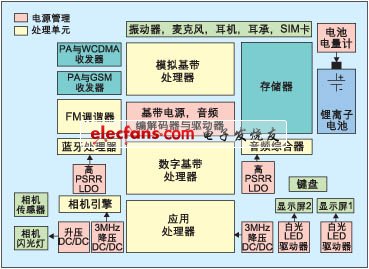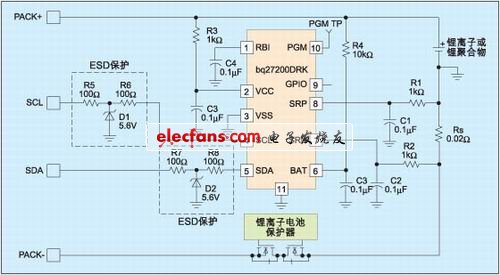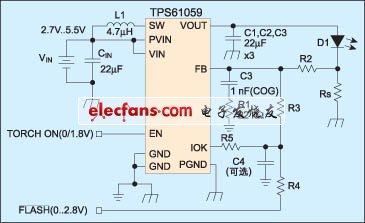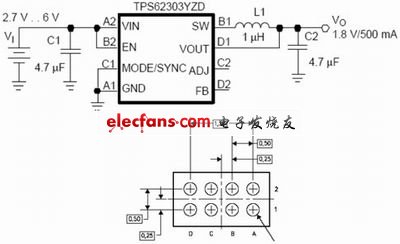Third-generation (3G) phones offer a variety of features with more features. As consumers enjoy the latest and better features of these communication devices, they continue to require longer battery life and smaller form factor. While IC integration can help solve size problems, it also increases design complexity and limits design flexibility. Today's mobile phone design engineers must consider a variety of factors to effectively optimize battery usage to extend battery life. Therefore, a highly integrated power management unit and high-performance discrete devices must be used for battery management, power conversion, and system management.
This article refers to the address: http://

Figure 1: Block diagram of the system components of a 3G mobile phone.
Dilemma: function and battery power
When designing an advanced wireless device, design engineers face a dilemma. On the one hand, they need to integrate many functions into a specific form factor that is usually determined by the size of the battery and display, complex user interface and design engineering; on the other hand, the available energy of the battery depends on determining their energy density. With the chemical characteristics of physical dimensions, these ever-changing parameters often force design engineers to use battery power more efficiently to meet consumer demand for standby time and working time.
Today's 3G multifunction phones can support multiple air interfaces, providing multi-band modem connections such as GSM and WCDMA, as well as other connections via Bluetooth, wireless LAN, infrared and USB interfaces. Digital camera functionality has become standard on many mobile phones, requiring sophisticated camera engines and high-brightness flash to capture high-quality photos. As the data transmission speed increases, the videophone function of the mobile phone is also possible. In addition, high-speed application processors provide powerful audio/video processing capabilities to support digital television (DTV) signals and MPEG audio codecs. Newer models will also add FM radio and digital TV tuners to increase the entertainment value of mobile phones. The increase in data throughput will ultimately require high-density storage capacity, which can be achieved through memory expansion slots or even micro hard drives. It's not hard to imagine that most of these wireless devices will also have the functionality of a portable gaming device.
Batteries as a source of energy play an important role in the system. Today, almost 100% of 3G phones use lithium-ion batteries, which are the most energy-intensive of all rechargeable chemical batteries. Most batteries have a size of approximately 50 x 40 x 5 mm and a capacity between 900 mAh and 1,200 mAh. Although the energy density that fuel cell technology can provide will be much higher than the energy density of lithium-ion batteries, it is expected that fuel cells will be widely used for several years due to technical and policy issues. In addition, lithium-ion battery technology is expected to gradually improve, and its battery capacity may increase by 30 (. Therefore, system engineers will continue to use lithium-ion batteries that provide approximately 1,500-1,800 mAh capacity.
This dilemma will eventually drive digital and analog semiconductor technology to the next lower power node and drive the development of ultra-efficient battery technology.
Integration and layout issues
Obviously, as all functions are integrated into a relatively small device, it becomes necessary to integrate a suitable set of high performance analog and digital devices. To emphasize the complexity of this integration, Figure 1 shows the main system architecture of a 3G handset.

Figure 2: Battery fuel gauge for accurate battery power measurement.
But the question is: Which devices need to be integrated and how to address the impact of the phone's form factor on the device layout? An obvious answer is the integration of standard power supplies for baseband processors, audio subsystems and interface devices. These standard power supplies are different phones. Platforms and handset vendors using the same basic chipset. But there are two inherently significant challenges.
First, industrial design considerations will allow mobile phones to be designed in many different ways depending on the desired functionality and ergonomics. Now, electrical design needs to take into account that the phone may be designed as a bar, clamshell or sliding phone, all with different display, keyboard and Speaker configurations. These design differences have a large impact on how to place the display backlight, camera modules, and other subsystems, and to some extent limit the integration of these components. Sometimes "integrated" integration of power or audio functions can mean longer traces, complex board layouts, or electrical design challenges caused by noise.
Second, handset manufacturers need cost-effective management of handset models. In order to meet market demand with different mobile phone models, handset manufacturers must offer products with different levels of features and performance, and the prices of these products are also different. In order to get the most profit from a highly competitive market, the cost of these phones must change with functionality, and this will not integrate every function into a large IC. If a feature is not what a given phone model is, then this particular feature and its power supply should be removed from the board to reduce cost.
In addition, handset manufacturers using the same basic chipset also need to differentiate their products from competitors, which also encourages integration of various key features to maintain product differentiation. Typical examples of product differentiation may include (but are not limited to): brighter camera flash, more powerful blower mode, Class D stereo audio performance, special display and keyboard backlighting, MP3 audio playback, FM radio, and precision Battery fuel metering, etc.
Discrete power device selection
As shown in Figure 1, a typical non-integrated power supply that powers different sub-components may be a battery fuel gauge as part of a mobile phone battery pack, a high-efficiency but small-sized high-frequency DC/DC core power supply, and a camera flash white LED. High-performance DC/DC boost drivers, white LED backlight drivers with OLED power supplies, secondary displays, and linear regulators with ultra-low power supply rejection ratio (PSRR). In most integrations, first integrate some of the existing features that consumers like, while leading analog semiconductor technologies with higher performance and efficiency, including optimized discrete power management devices, will increase with shipments. The standardization of functions is gradually being integrated more and more.

Figure 3: High-efficiency step-up DC/DC converter that drives high-brightness camera flash LEDs.
To further optimize power management and maximize battery life, there are three important aspects that must be considered. First, battery management must be able to handle battery charging and power measurement. Second, power conversion must convert battery power to the power available to system components as efficiently as possible. Third, the system power management used to analyze the actual power consumption of the processor and control multiple power supplies must optimize battery usage. The first two issues can be specifically addressed by selecting the appropriate power management device, while the third issue is related to the development of the main processing software.
In battery management, battery "fuel gauges" are becoming increasingly popular. Traditionally, battery power is typically measured by first measuring the voltage of a lithium-ion battery and then using the battery lookup table stored in memory to find out the available battery power. This method is based on a voltage-charge lookup table for a particular lithium-ion battery, but this method is not feasible due to the complex power consumption characteristics of the 3G handset and the performance of the lithium-ion battery as a function of time, temperature and load conditions. In order to accurately measure the remaining battery power so that the processor can better manage the power consumption of the mobile phone, people use a high-performance coulomb counter with "impedance tracking" capability to measure the actual charge in and out of the battery, which will enable the processor to effectively Run in battery save mode, accurately calculate the time the battery is exhausted, and warn the end user when charging is needed. The coulomb counter shown in Figure 2 is integrated into the battery pack and sends battery parameters to the host processor via the I2C communication interface.
In the field of power conversion, DC/DC converters play an increasingly important role in providing efficient power supply solutions for LED drivers and processor core power supplies. To improve the performance of digital photography and video conferencing, the resolution of CMOS and CCD sensors is increasing. As the resolution of the sensor continues to increase, a brighter light is required to produce a high-quality photo, which in turn will require a brighter solution for the camera flash. When the resolution of a camera phone is greater than 1 million pixels, at least 50 lux of brightness is required to take high-quality photos. At present, the brightness of flash lamps that many mobile phones can provide is lower than this. The driving current of flash white LEDs is less than 100mA. This design does not actually improve the photo quality. To really improve the quality of the photo, it is necessary to drive a high-power white LED with a current of nearly 1A. It is difficult to supply 1A with a charge pump because the battery current will reach 2A, which will exceed the system's reserved for such functions. Any battery power budget. To address the problem of excessive battery current, the high-efficiency DC/DC boost converter shown in Figure 3 provides up to 700mA for white LEDs in camera flash applications.

Figure 4: High-frequency 3MHz DC/DC converter in a small package.
Several subsystems in the phone may also require an accurate core voltage. Linear regulators are generally considered to be a small, low-cost solution for voltage regulation, but when the current is greater than 200 mA, they will begin to require space-consuming and expensive heat sinks due to excessive power losses. The power loss is due to the large input-output voltage difference at the time of power supply. The product of this voltage difference and the output current is equal to the power loss. For example, a 1.2V/500mA core voltage is obtained from a 3.6V lithium-ion battery. When the linear regulator is regulated at 33% efficiency and consumes a lot of battery power and generates a lot of heat, the DC/DC converter works well with an efficiency higher than 90%, and only consumes LDO work. A small part of the consumption.
The latest generation of DC/DC converters with state-of-the-art analog technology and design technology has several space-saving features. Figure 4 shows an ultra-small, high-precision DC/DC buck converter that provides up to 500mA of core current. Because of the integration of two switching transistors, the circuit requires only one inductor and two small capacitors. The unique control architecture allows the power supply to react quickly to load transients and maintain ±1 (high voltage regulation accuracy (which is required by today's high-performance processing cores). The 3MHz switching frequency reduces the inductor size to Only 1uH, allowing the use of thin chip inductors less than 1mm in height. The device is also available in a chip scale package with IC size down to 2 x 1mm, so the entire solution can be built to fit in a 5 x 5mm2 space To further reduce power consumption, the advanced DC/DC regulator also features automatic pulse frequency modulation (PFM) / pulse width modulation (PWM) mode conversion to maximize conversion efficiency over a wide load range. In this case, the converter operates in PFM mode, and when the load current is greater than 50mA, PWM control is used, which can provide 1.8V/500mA core power from 80% to 90% efficiency.
Summary of this article
The integration of power supplies with other analog devices is inevitable, and the key is to select features that have evolved into standards and are adopted by multiple mobile platforms. Leading technologies that drive functional differentiation are generally first applied to discrete components that can be customized for features, which is important for consumer and handset model management. In summary, power management devices continue to challenge their limits in terms of size, efficiency, and power consumption, and play an important role in reducing the form factor and weight of mobile phones.
Piezo Transducer,Piezo Audio Transducer,Piezoceramic Transducer,Piezo Pressure Transducer
NINGBO SANCO ELECTRONICS CO., LTD. , https://www.sancobuzzer.com